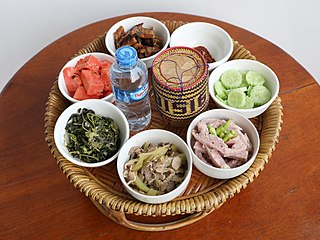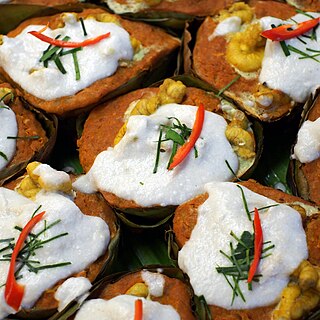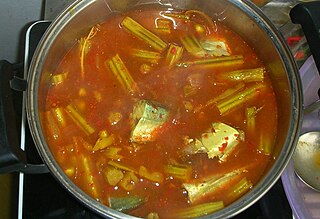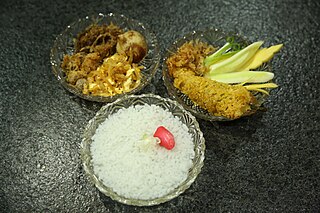
Thai cuisine is the national cuisine of Thailand.

Lao cuisine or Laotian cuisine is the national cuisine of Laos.

Phetchaburi or Phet Buri is one of the western or central provinces (changwat) of Thailand. Neighboring provinces are Ratchaburi, Samut Songkhram, and Prachuap Khiri Khan. In the west it borders the Tanintharyi Division of Myanmar. Phetchaburi is home to Kaeng Krachan National Park.

Green papaya salad is a spicy salad made from shredded unripe papaya. It is generally believed to have been created by the Lao people and is considered one of the national dishes of Laos. Green papaya salad is also popular in neighbouring Thailand's Isan region, whose population is mainly composed of ethnic Lao and from where it spread to the rest of Thailand known as som tam. Green papaya salad has also spread to the rest of the continental Southeast Asia, as well as Xishuangbanna (China).

Noodle soup refers to a variety of soups with noodles and other ingredients served in a light broth. Noodle soup is a common dish across East Asia, Southeast Asia and the Himalayan states of South Asia. Various types of noodles are used, such as rice noodles, wheat noodles and egg noodles.

Green curry is a central Thai variety of curry.

Massaman curry is a rich, flavourful, and mildly spicy Thai curry. It is a fusion dish, combining ingredients from three sources: Persia, the Indian Subcontinent, and the Malay Archipelago with ingredients more commonly used in native Thai cuisine to make massaman curry paste. The substance of the dish is usually based on chicken or other meat, potatoes, onions, and peanuts. The richness comes from the coconut milk and cream used as a base, as for many Thai curries.

Thai curry is a dish in Thai cuisine made from curry paste, coconut milk or water, meat, seafood, vegetables or fruit, and herbs. Curries in Thailand mainly differ from the curries in India in their use of ingredients such as fresh rhizomes, herbs, and aromatic leaves rather than a mix of dried spices.

Thai fried rice is a variety of fried rice typical of central Thai cuisine. In Thai, khao means "rice" and phat means "of or relating to being stir-fried."

Pla ra, similar to padaek in Laos, is a traditional Thai seasoning produced by fermenting fish with rice bran or roasted rice flour and salt fermented in a closed container for at least six months. Fermented fish seasoning are commonly found in Cambodian, Lao, Mon, Thai and Vietnamese cuisine. Pla ra has a very strong smell, which is considered unpleasant by some people. Its flavors are salty and sour, depending on the amount of salt put in and lactic acid resulting from fermentation process.

Economy rice or economic rice is a type of food or food stall serving many dishes accompanied by rice, commonly found in hawker centres, street vendors or food courts in Malaysia and Singapore. Specifically in Singapore, it is commonly known as cai png, from the Hokkien 菜饭; cài fàn; chhài-pn̄g. In recent times, due to COVID-19 restrictions and its associated economic impact, this concept has also become popular in Hong Kong.

Steamed curry is a type of Southeast Asian curry that is traditionally cooked by steaming or roasting in banana leaves and served with cooked rice. The curry base is typically made with a paste, either curry paste or fish paste, and may also include coconut cream or coconut milk and eggs. A variety of leaves and staple ingredients are often added to enhance the flavor of the dish.

Kaeng som, gaeng som, Asam rebus, or Thai/Lao/Malaysian sour curry is a sour and spicy fish curry or soup with vegetables popular in Southeast Asia. The curry is characteristic for its sour taste, which comes from tamarind (makham). The recipe uses palm sugar to sweeten the curry.

Khanom chin or Khanom jeen are fresh, thin rice noodles in Thai cuisine which are made from rice sometimes fermented for three days, boiled, and then made into noodles by extruding the resulting dough through a sieve into boiling water. Khanom chin is served in many kinds of stock: coconut milk, fish curry, and chilli.

Kaeng tai pla is a curry of southern Thai cuisine. Its name is derived from tai pla, a salty sauce made from fermented fish entrails, which gives the curry a strong smell and flavor.

Khao chae is "rice soaked in cool water". "Khao" means "rice" and "chae" means "to soak". Around the time of King Rama II, the recipe was adapted from a Mon dish and then modified. It was meant to be made and consumed in the hot season, from mid-March to the end of April. Ice was not then available in Thailand, so the water was kept cool during hot season by putting it in an earthenware vessel in a shaded place. Some old recipes call for the use of camphor to cool the dish.

Mango sticky rice is a traditional Southeast Asian and South Asian dessert made with glutinous rice, fresh mango and coconut milk, and eaten with a spoon or the hands.

Nasi campur, also known as nasi rames or sego campur in Java, refers to an Indonesian and Malay dish of a scoop of nasi putih accompanied by small portions of several other dishes, which includes meats, vegetables, peanuts, eggs, and fried-shrimp krupuk.

Street food in Thailand brings together various offerings of ready-to-eat meals, snacks, fruits and drinks sold by hawkers or vendors at food stalls or food carts on the street side in Thailand. Sampling Thai street food is a popular activity for visitors, as it offers a taste of Thai cooking traditions. Bangkok is often mentioned as one of the best places for street food. In 2012, VirtualTourist named Bangkok as the number one spot for street food—the city is notable for both its variety of offerings and the abundance of street hawkers.

Baan Varnakovida is a restaurant in Phra Nakhon, Bangkok, Thailand, specializing in pre-war Siamese cuisine. Owned by Apavinee Indaransi, Baan Varnakovida is housed in a Rama VI-era gingerbread house on Tanao Road. The 2-acre lot was bestowed on Indaransi's grandfather, Luang (หลวง) Krachang Varnakovida, for serving as a royal chancellor to King Rama VI. The restaurant is known for khao chae, jasmine rice soaked in flower-infused water served with accompaniments. Other notable dishes include khao khluk kapi and khanom chin sao nam.





















